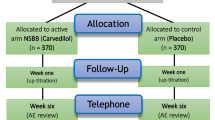Abstract
Background
Primary Biliary Cholangitis (PBC, formerly cirrhosis), is a chronic cholestatic liver disease which until spring 2016 had a single licensed therapy, Ursodeoxycholic acid (UDCA). Approximately 30% of patients do not respond to UDCA, and are high-risk for progressing to end stage liver disease, transplantation or death. A new era of stratified medicine with second-line therapies to treat high-risk disease is emerging, with the first such second-line agent obeticholic acid recently receiving FDA and EMA approval and entering practice. Recent experience in the USA of inappropriate use and associated deaths has highlighted concerns as to whether clinicians have the knowledge to implement second-line therapies appropriately and safely.
Methods
Online survey of knowledge regarding optimal PBC management in Gastroenterologists and Hepatologists in the USA; the first 100 completed responses from each group used for analysis.
Results
80% of Hepatologists felt they were highly competent in their understanding of the importance of early diagnosis and early UDCA therapy in PBC compared with 65% of gastroenterologists. However, only 36% of Hepatologists and 30% of gastroenterologists felt competent at assessing response to UDCA. Competence in knowledge (mode of action, efficacy, and side effects) of second-line therapies and enrollment into trials was low among both groups.
Conclusion
Significant knowledge gaps in clinicians managing PBC presents a problem in optimizing care. It is perhaps not surprising that knowledge of emerging second-line therapies is low, however more concerning is sub-optimal use of UDCA in real-life practice and the lack of confidence at assessing treatment response which should be a routine part of clinical practice to assess risk of disease progression and will be key in delivering stratified medicine.






Similar content being viewed by others
Abbreviations
- EMA:
-
European medicines agency
- FDA:
-
Food and drug administration
- OCA:
-
Obeticholic acid
- PBC:
-
Primary biliary cirrhosis
- PIK:
-
Projects in knowledge
- UCDA:
-
Ursodeoxycholic acid
References
Jones DEJ. Pathogenesis of primary biliary cirrhosis. Gut. 2007;56:1615–1624.
Metcalf JV, Bhopal RS, Gray J, James OFW. Incidence and prevalence of primary biliary cirrhosis in the city of Newcastle-upon-Tyne, England. Int J Epidemiol. 1997;26:830–836.
Loufgren J, Jaurnerot G, Danielsson D, Hemdal I. Incidence and prevalence of primary biliary cirrhosis in a denned population in Sweden. Scand J Gastroenterol. 1985;20:647–650.
Danielsson A, Boqvist L, Uddenfeldt P. Epidemiology of primary biliary cirrhosis in a defined rural population in the northern part of Sweden. Hepatology. 1990;11:458–464.
Kim WR, Lindor KD, Locke GR, et al. Epidemiology and natural history of primary biliary cirrhosis in a US community. Gastroenterology. 2000;119:1631–1636.
Poupon RE, Lindor KD, Cauch-Dudek K, Dickson ER, Poupon R, Heathcote EJ. Combined analysis of randomized trials of ursodeoxycholic acid in primary biliary cirrhosis. Gastroenterology. 1997;113:884–890.
Beuers U, Boberg KM, Chazouilleres O, et al. EASL practice guidelines on management of cholestatic liver diseases. J Hepatol. 2009;51:237–267.
Lindor KD, Gershwin ME, Poupon R, et al. Primary biliary cirrhosis. Hepatology. 2009;50:291–308.
Pares A, Caballeria L, Rodes J. Excellent long-term survival in patients with primary biliary cirrhosis and biochemical response to ursodeoxycholic acid. Gastroenterology. 2006;130:715–720.
Gong Y, Huang Z, Christensen E, Gluud C. Ursodeoxycholic acid for patients with primary biliary cirrhosis: an updated systematic review and meta-analysis of randomized clinical trials using Bayesian approach as sensitivity analyses. Am J Gastroenterol. 2007;102:1799–1807.
Carbone M, Mells G, Pells G, et al. Sex and age are determinants of the clinical phenotype of primary biliary cirrhosis and response to ursodeoxycholic acid. Gastorenterology. 2013;144:560–569.
Hirschfield GM, Beuers U, Corpechot C, et al. EASL clinical practice guidelines: the diagnosis and management of patients with primary biliary cholangitis. J Hepatol. 2017;67:145–172.
Lu M, Li J, Haller IV, Romanelli RJ, et al. Factors associated with prevalence and treatment of primary biliary cholangitis in United States health systems. Clin Gastroenterol Hepatol. 2017. https://doi.org/10.1016/j.cgh.2017.10.018.
Nevens F, Andreone P, Mazzella G, et al. The first primary biliary cirrhosis (PBC) phase 3 trial in two decades-an international study of the FXR agonist obeticholic acid. J Hepatol. 2014;60:S525–S526.
Honda A, Ikegami T, Nakamuta M, et al. Anticholestatic effects of bezafibrate in patients with primary biliary cirrhosis treated with ursodeoxycholic acid. Hepatology. 2013;57:1931–1941.
Kanda T, Yokosuka O, Imazeki F, Saisho H. Bezafibrate treatment: a new medical approach for PBC patients? J Gastroenterol. 2003;38:573–578.
Myers RP, Swain MG, Lee SS, Shaheen AAM, Burak KW. B-cell depletion with Rituximab in patients with primary biliary cirrhosis refractory to ursodeoxycholic acid. Am J Gastroenterol. 2014;108:933–941.
Tsuda M, Moritoki Y, Lian Z-X, et al. Biochemical and immunologic effects of Rituximab in patients with primary biliary cirrhosis and an incomplete response to ursodeoxycholic acid. Hepatology. 2012;55:512–521.
Corrigan M, Vale L, Coughlan D, Jones D, Hirschfield G. Clinician confidence in stratifying risk in primary biliary cirrhosis-a Uk-pbc survey. Hepatology. 2015;62:526A.
Funding
Data capture was funded by Projects in Knowledge in the context of educational material development. PP and ER are employed by Projects in Knowledge. DJ and LJ are funded by the Medical Research Council in the UK.
Author information
Authors and Affiliations
Contributions
DJ, ER and PP were involved in the design of this study. LJ, AK, DJ, MC, ER and PP were involved in drafting this manuscript.
Corresponding author
Ethics declarations
Conflict of interest
The authors declare that they have no conflict of interest.
Additional information
Amardeep Khanna and Laura Jopson are joint first authors.
Rights and permissions
About this article
Cite this article
Jopson, L., Khanna, A., Peterson, P. et al. Are Clinicians Ready for Safe Use of Stratified Therapy in Primary Biliary Cholangitis (PBC)? A Study of Educational Awareness. Dig Dis Sci 63, 2547–2554 (2018). https://doi.org/10.1007/s10620-018-5074-8
Received:
Accepted:
Published:
Issue Date:
DOI: https://doi.org/10.1007/s10620-018-5074-8




